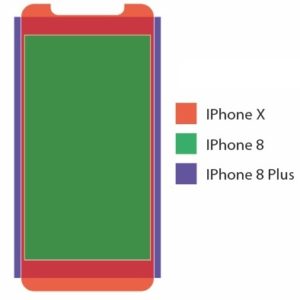iPhone X, iPhone 8 and iPhone 8 Plus Screen Comparison
So, there are two major difference between the three 2017 iPhone models: size and type. Check out the image available nearby to make yourself a better idea about the display real estate differences between the iPhone X, 8 and 8 Plus. Notice that “iPhone [ten]” has the tallest display of the three iOS devices, however the length of the “Safe Area” is identical to the iPhone 8 Plus display. That’s because the “ears” between the top notch and a small area at the bottom of the display are currently used by Apple only. This means that the iPhone X is only displaying edge-to-edge when running built-in iOS apps, full-screen videos and games. Third party app developers aren’t currently allowed to stretch within the “Safe Zone”.
 When it comes to width the iPhone 8 Plus wins the comparison, while the iPhone X is just marginally bigger when compared to the iPhone 8. However, it’s worth mentioning that the bezel-free display makes the “iPhone [ten]” the most space-efficient device of the group. Total width and length of the actual case makes the OLED iPhone an one-handed smartphone with the screen real estate similar to the two-hand operated iPhone 8 Plus. Now let’s take a look at the actual figures and see how big the differences actually are.
When it comes to width the iPhone 8 Plus wins the comparison, while the iPhone X is just marginally bigger when compared to the iPhone 8. However, it’s worth mentioning that the bezel-free display makes the “iPhone [ten]” the most space-efficient device of the group. Total width and length of the actual case makes the OLED iPhone an one-handed smartphone with the screen real estate similar to the two-hand operated iPhone 8 Plus. Now let’s take a look at the actual figures and see how big the differences actually are.
iPhone X vs iPhone 8 vs iPhone 8 Plus Total Size & Weight
Width: 2.79 inches (70.9 mm) | 2.65 inches (67.3 mm) | 3.07 inches (78.1 mm).
Height: 5.65 inches (143.6 mm) | 5.45 inches (138.4 mm) | 6.24 inches (158.4 mm).
Depth: 0.30 inch (7.7 mm) | 0.29 inch (7.3 mm) | 0.30 inch (7.5 mm).
Weight: 6.14 ounces (174 grams) | 5.22 ounces (148 grams) | Weight: 7.13 ounces (202 grams).
iPhone X vs iPhone 8 vs iPhone 8 Plus Screen Size
Width: 2.46 inches (62.4 mm) | 2.30 inches (58.44 mm) | 2.69 inches (68.41 mm).
Height: 5.32 inches (135.1 mm) | 4.09 inches (103.94 mm) | 4.79 inches (121.62 mm).
iPhone X vs iPhone 8 vs iPhone 8 Plus Resolution
Width: 1125 | 750 | 1080.
Height: 2436 | 1334 | 1920.
Pixel Density: 458 ppi | 326 ppi | 401 ppi.
OLED v LCD iPhone Benefits & Disadvantages
OLED displays come with a series of advantages when compared to LCD ones, however they also include an important downside. I’ve listed them out for you for a better look:
Benefits:
– OLED-based displays are more energy efficient because they don’t use a backlight panel that is always on. Each pixel can be lit up, only when necessary.
– They OLED display modules are also thinner. This allows Apple to build slimmer iPhones or to accommodate a larger battery, or other internals.
– OLEDs also manage to display darker blacker and brighter white colors.
Disadvantages:
– There are less suppliers of OLED panels. Samsung is the biggest producer and this delays the iPhone X availability. The manufacturing monopoly for such a large number of displays, required by Apple contributes to the iPhone X’s 4 figure pricing.
Has this comparison helped you out. Will you upgrade to a 2017 iPhone? What model do you intend to pick? Pre-orders are open!


Thanks so much for this! Very helpful!